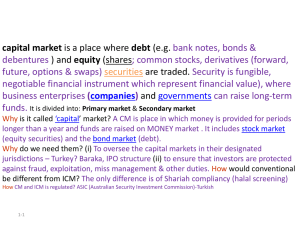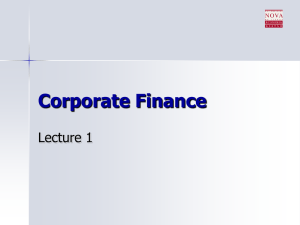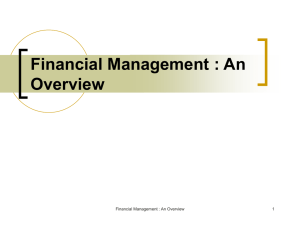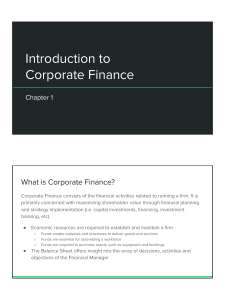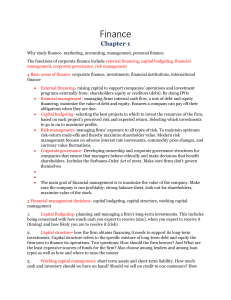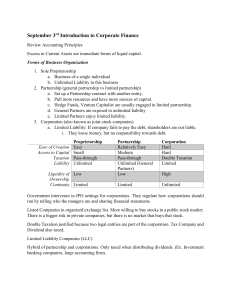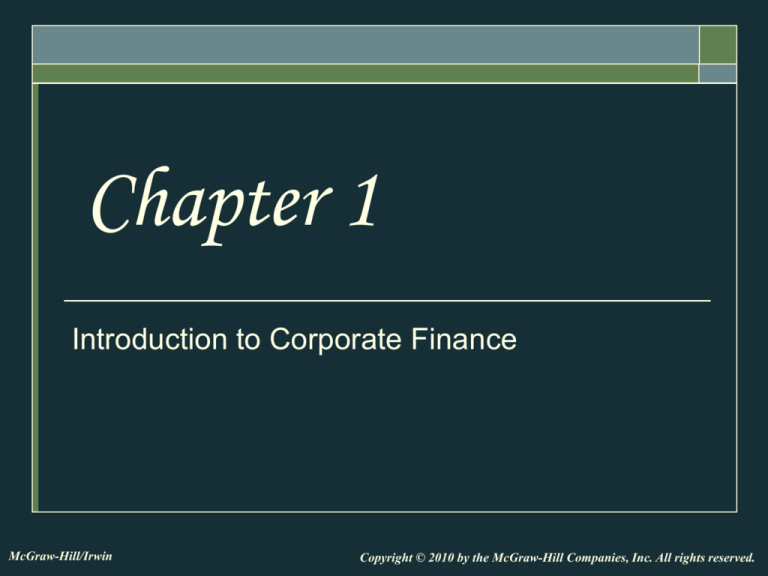
Chapter 1
Introduction to Corporate Finance
McGraw-Hill/Irwin
Copyright © 2010 by the McGraw-Hill Companies, Inc. All rights reserved.
Key Concepts and Skills
Know
the basic types of financial management
decisions and the role of the Financial Manager
Know the financial implications of the various
forms of business organization
Know the goal of financial management
Understand the conflicts of interest that can
arise between owners and managers
Understand the various regulations that firms
face
1-1
Chapter Outline
1.1 What is Corporate Finance?
1.2 The Corporate Firm
1.3 The Importance of Cash Flows
1.4 The Goal of Financial Management
1.5 The Agency Problem and Control of the
Corporation
1.6 Regulation
1-2
1.1 What Is Corporate Finance?
Corporate Finance addresses the following
three questions:
1.
2.
3.
What long-term investments should the firm
choose?
How should the firm raise funds for the selected
investments?
How should short-term assets be managed and
financed?
1-3
Balance Sheet Model of the Firm
Total Value of Assets:
Current Assets
Total Firm Value to Investors:
Current
Liabilities
Long-Term
Debt
Fixed Assets
1 Tangible
2 Intangible
Shareholders’
Equity
1-4
The Capital Budgeting Decision
Current
Liabilities
Current Assets
Long-Term
Debt
Fixed Assets
1 Tangible
2 Intangible
What long-term
investments
should the firm
choose?
Shareholders’
Equity
1-5
The Capital Structure Decision
Current Assets
How should the
firm raise funds
for the selected
Fixed Assets
investments?
1 Tangible
2 Intangible
Current
Liabilities
Long-Term
Debt
Shareholders’
Equity
1-6
Short-Term Asset Management
Current Assets
Fixed Assets
1 Tangible
2 Intangible
Current
Liabilities
Net
Working
Capital
How should
short-term assets
be managed and
financed?
Long-Term
Debt
Shareholders’
Equity
1-7
The Financial Manager
The Financial Manager’s primary goal is to
increase the value of the firm by:
1. Selecting value creating projects
2. Making smart financing decisions
1-8
Hypothetical Organization Chart
Board of Directors
Chairman of the Board and
Chief Executive Officer (CEO)
President and Chief
Operating Officer (COO)
Vice President and
Chief Financial Officer (CFO)
Treasurer
Controller
Cash Manager
Credit Manager
Tax Manager
Cost Accounting
Capital Expenditures
Financial Planning
Financial Accounting
Data Processing
1-9
1.2 The Corporate Firm
The corporate form of business is the standard
method for solving the problems encountered
in raising large amounts of cash.
However, businesses can take other forms.
1-10
Forms of Business Organization
The Sole Proprietorship
The Partnership
General Partnership
Limited Partnership
The Corporation
1-11
A Comparison
Corporation
Partnership
Liquidity
Shares can be easily
exchanged
Subject to substantial
restrictions
Voting Rights
Usually each share gets one
vote
General Partner is in charge;
limited partners may have
some voting rights
Taxation
Double
Partners pay taxes on
distributions
Reinvestment and dividend
payout
Broad latitude
All net cash flow is
distributed to partners
Liability
Limited liability
General partners may have
unlimited liability; limited
partners enjoy limited
liability
Continuity
Perpetual life
Limited life
1-12
1.3 The Importance of Cash Flow
Firm
Firm issues securities (A)
Invests
in assets
(B)
Retained
cash flows (F)
Short-term debt
Cash flow
from firm (C)
Dividends and
debt payments (E)
Taxes (D)
Current assets
Fixed assets
Financial
markets
Ultimately, the firm
must be a cash
generating activity.
Government
Long-term debt
Equity shares
The cash flows from
the firm must exceed
the cash flows from
the financial markets.
1-13
1.4 The Goal of Financial Management
What is the correct goal?
Maximize profit?
Minimize costs?
Maximize market share?
Maximize shareholder wealth?
1-14
1.5 The Agency Problem
Agency
relationship
Principal
hires an agent to represent his/her interest
Stockholders (principals) hire managers (agents) to
run the company
Agency
problem
Conflict
of interest between principal and agent
1-15
Managerial Goals
Managerial goals may be different from
shareholder goals
Expensive perquisites
Survival
Independence
Increased growth and size are not necessarily
equivalent to increased shareholder wealth
1-16
Managing Managers
Managerial
compensation
Incentives
can be used to align management and
stockholder interests
The incentives need to be structured carefully to
make sure that they achieve their intended goal
Corporate
control
The
threat of a takeover may result in better
management
Other
stakeholders
1-17
1.6 Regulation
The Securities Act of 1933 and the Securities
Exchange Act of 1934
Issuance of Securities (1933)
Creation of SEC and reporting requirements
(1934)
Sarbanes-Oxley (“Sarbox”)
Increased reporting requirements and
responsibility of corporate directors
1-18
Quick Quiz
What
are the three basic questions Financial
Managers must answer?
What are the three major forms of business
organization?
What is the goal of financial management?
What are agency problems, and why do they
exist within a corporation?
What major regulations impact public firms?
1-19


